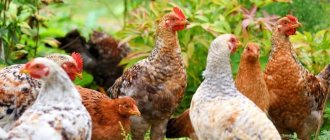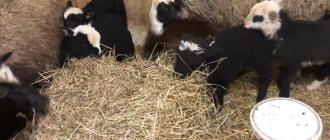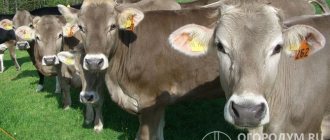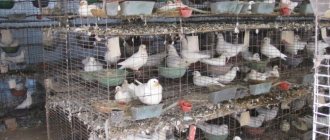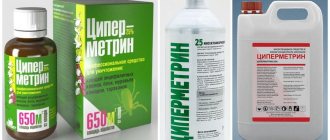855
4 comments
1
Author:
Ryzhakova Evgenia.
Reading time: 2 minutes
Corn is not the main food crop for chickens - they are more willing to eat wheat, barley or rye. Nevertheless, in the diet of birds with full-fledged rearing, corn cannot be avoided.
Let's try to figure out which variety is healthier - sugar or feed (feed) corn? There are some points here that cannot be ignored.
Is it possible to feed chickens corn?
Breeding and raising chickens is almost impossible without adding corn to their diet. However, you should not make corn the basis of feeding. With great interest, birds feed on wheat, barley, and rye.
In the article we tell you what kind of corn is better to feed chickens - sugar or fodder variety. There are several rules for feeding birds with this vegetable.
Mash feeding
I give the mash to pullets from the first day until slaughter, with a difference - if the pullets are from a poultry farm, then they need to be accustomed to it gradually
The first day they eat very little mash. For example, for 20 chickens the size of a fist and every day, very gradually increase the portion. While they get used to it, I give more feed
GRAIN FEEDING
I use whole grain in dry form. Wheat and barley. Grain proportions: wheat 80-90% remaining 10-20% barley
FEEDING TIME IN SUMMER
Mash
in the morning from 6 to 7 o'clock
Grain
in the afternoon from 13 to 14 o'clock or at your discretion, at least in constant access
FEEDING TIME IN WINTER
Mash
in the morning from 6 to 7
Grain
is constantly in the feeder
PS At night in winter and summer, chickens sleep with a crop full of grain, calcium is gradually produced from it for the formation of eggs and, to a greater extent, shells. It is advisable that the grain be present before the lights are turned off
Nutrition at one month of age
At an advanced age of up to 50 days, chickens should already be fed dry grains and corn. Few farmers prepare their own feed at this age. Broiler chickens are a rather rare case, because for them it is allowed to mix “assorted” grains from different grains. You can give mash every day with millet and oats. Many people give corn to taste the meat and gain fat. You can make an assortment of different grains as follows: mix peas with crushed wheat and barley. The approximate and best composition of such a “cocktail” is at least 2 types of grains, proteins and mineral supplements or mineral-containing premixes.
Feed consumption rates may vary. Wet mash at a clearly established time will not hurt either. It is up to the breeder to decide in what proportions and quantities to mix grain feed. Also at this age, yeast is a mandatory element of feeding. Every day, every chicken must eat at least a little yeast for effective growth.
It is recommended to use fish oil as a source of vitamins. But yeast should always be a mandatory element in the broiler menu. With properly selected nutrition and stable feeding, a broiler chicken can gain up to 4 kg of weight by 2.5 months. Some breeders prefer to steam their food. Porridges steamed with fish and meat waste, sprouted grains, grass, etc. can almost completely replace compound feed, but not all farmers come to this feeding method. If these simple rules are followed, even a small subsidiary plot can bring good profits to the farmer.
Is it possible to feed chickens corn?
Laying hens include cereals in their diet from late autumn until the first green grass appears. Due to its high carbohydrate content, corn allows chickens to produce energy and retain heat for longer.
To raise chickens, grain is given from the first days of life to 4 months, regardless of the time of year.
Broilers can be fed grains every day from 3 weeks of age until slaughter.
Do-it-yourself chicken feed
If there is no suitable feed for chickens on sale, you can prepare the feed yourself. The starting mixture should include the following products:
- 49% corn;
- 18% sunflower cake or meal;
- 12% wheat;
- 8% fish or meat and bone meal;
- 3% return;
- 3% herbal ingredients;
- 1% feed fat.
All components should be pre-ground and only then combined into compound feed. You need to make such food for babies only from the ingredients that they have already been given, otherwise the youngsters may have problems with digestion.
Broiler chickens can be fed dry feed from the first days of life. But this product is introduced into the diet of young egg-producing animals only from the age of one week.
Chickens should not be given granulated feed - the chicks will not be able to crush and swallow it. Therefore, such food is first ground, and only then poured into feeders.
When is the best time to feed laying hens?
In the intervals between morning and evening feedings, you can let cabbage or greens peck, hanging it on the walls or hanging it from the ceiling of the house so that the bird can reach it. Greens do not contribute to obesity, and birds peck at them with great pleasure. In the warm season, feeding can be done according to various regimes. Where the bird uses spacious walks covered with vegetation, it is enough to feed it once a day - in the morning. During a short night the bird will not get hungry. In autumn, when the bird can eat grains on the stubble, there is no need to feed it at all. Where there are no spacious walks, the bird needs to be fed more often than in winter, namely 3 times a day.
How to properly soak and sprout oats?
To get oats with sprouts, you need to do the following:
- Prepare the container, that is, wash it well, and at the end treat it with a pink solution of potassium permanganate.
- In the evening, add grain and water with water at a temperature of at least 15 degrees. When calculating the amount of dry oats, you should proceed from 20 g per chicken.
- In the morning, transfer 2/3 of the grain mass into a bag and leave it to drain.
- When all the moisture has gone, place the oats in a cool place where the grains will germinate. In this case, the bag should be placed on its side, and its contents should be distributed in an even layer, no more than 5 cm high. If it is thicker, the wet oats will heat up and begin to deteriorate.
The next day, grain with sprouts can be given to chickens. The set aside 1/3 is also put into a bag and allowed to drain, but, unlike the first batch, it is placed in a warm place.
Such oats can be given to the bird half a day earlier, that is, in the evening.
The most valuable is considered to be grain with sprouts of 3 mm . It is given to chickens as a treat, an hour before dark (turning off the lights in the poultry house).
You don’t have to put the oats in the feeder, but scatter them directly onto the bedding. This dessert will be especially useful during the breeding season - from the beginning of winter to the end of spring.
It is important to know that cereals can only be kept wet for 3 days. Leaving it wet longer is dangerous for intestinal infections.
How to steam?
Steamed grain, like sprouted grain, is easier to process by the gastrointestinal tract and is better absorbed. To prepare such oats, pour boiling water over it, add some salt and simmer over low heat for 10 minutes.
When it cools down, drain the liquid, let it dry and feed it to the birds.
Sprouted wheat
The grain does not have to be crushed or given whole. Today, sprouted grains, such as wheat, are very popular. This food for chickens is extremely healthy because:
- strengthens the bird's immune system;
- improves the quality of chicken meat (it becomes more elastic and less greasy);
- increases egg production of laying hens;
- the birds' skeleton and their muscular system are strengthened;
- improves the functioning of the gastrointestinal tract.
Sprouted grain changes its chemical composition. This contributes to the intake of a large number of useful components into the birds’ bodies. To digest dry wheat grain, chicken spends a lot of energy and time. In dry form, only 50-60% of the product is absorbed. If we are talking about sprouted food, it is absorbed by almost 95%.
How to germinate grain for chickens:
- High-quality wheat is selected, not rotten or old.
- Select a container for soaking grain. For this, it is better to use glass or ceramic dishes. It is not recommended to soak wheat in metal or plastic containers. This will reduce its nutritional value.
- The wheat is placed in a bowl and filled with warm water, the temperature of which should be between 35 - 40°C. It should cover the grain by 2 - 3 cm.
- The container is covered with a lid and left in this state for 14 - 18 hours.
- After this time, the excess water is drained, and the grain is scattered on a clean oilcloth. You need to germinate wheat or other grains in a special room where there are no drafts and low air humidity.
- Next, the grain is covered with a damp cloth, which needs to be moistened as it dries.
- After 2 - 3 days, strong shoots will be clearly visible.
Important! It is not recommended to germinate large quantities of grain at once. Its shelf life is short. If mold begins to form on the surface of the wheat, it should not be given to chickens.
Before sprouting wheat for chickens, it is worth knowing that it can bring not only benefits, but also harm the birds. For example, if you feed chickens a large amount of wheat germ per day, this will lead to hypervitaminosis. The maximum amount of such food per day should not exceed 30% of the total diet.
It is better to include sprouted wheat in the diet of poultry in winter or autumn. This is due to the fact that it is at this time that laying hens experience a lack of vitamins, which negatively affects their egg production. In this case, it is recommended that they be given sprouted wheat 2-4 times a week.
You can sprinkle this fertilizer directly on the floor of the poultry house or on the territory of the outdoor enclosure. This way, the chickens will be able to peck the food faster, which will prevent it from rotting.
Experienced breeders switch chickens that are obese to a low-calorie diet. Its essence lies in the fact that birds eat different types of sprouted grains. The duration of such a diet should not be more than 14 days. Otherwise, the chickens may become weak and sick.
How is corn good for chickens?
We are talking about concentrated food, the composition of which is rich in carbohydrates, vitamins and minerals. The chicken should eat all this together so that its health is strong and the required number of eggs is obtained. It is easily digested. In addition, corn grains are considered to be the most nutritious - they are yellow in color, which affects the color of the yolks. You can give them ground, coarsely crushed or whole.
We also recommend that you read: “Can broilers be given bread?”
Other healthy grains
In addition to wheat, it is recommended to include millet, pearl barley and rapeseed in the chicken diet.
It is recommended to include grains in the diet
Millet
Young breeders are interested in whether it is possible to feed millet to chickens? Millet is considered a very healthy cereal. It contains vitamins such as B1, B2, B5, PP, as well as phosphorus, magnesium, iron and other useful components.
It is a leader among grains that are used to feed poultry. It is even recommended to introduce boiled millet into the diet of chicks. The grain is pre-soaked in hot milk and then mixed with a boiled egg. A millet diet in adult chickens increases their egg production rate. If you introduce millet and millet into the diet of chickens, the shells on the eggs will be strong, and the laying hen will feel strong and healthy.
Important! In large factories, millet cereals are not cleaned, but given in their natural form.
Pearl barley
As for pearl barley, it is essential for chickens. It contains a large number of amino acids, as well as lysine, which prevent feather loss in birds. To feed chickens, it is recommended to use the most common pearl barley that has undergone preliminary preparation. In this case, the upper hard skin is removed from the grain. Since chickens do not chew their food, it is this type of grain that will be quickly digested in their stomach.
Barley can be given in crushed form, or it can be steamed like wheat. You need to know not only how to give pearl barley to chickens, it is important to have information on how much grain to give. Pearl barley should not exceed 20% of the bird's daily diet. Otherwise, disruption of the functioning of the gastrointestinal tract of birds cannot be avoided.
We should not forget about such a valuable and useful crop for birds as rapeseed. This plant contains many vitamins and microelements necessary for the normal growth and development of birds. It is also important that it contains only 1% fat. This prevents the development of obesity in chickens. Raw rapeseed is used to produce cake, flour and meal. All this can be used as poultry feed.
Important! Under no circumstances should rapeseed derivatives be poured with cold or hot water. In feed it is used only in dry and raw form.
Almost all grain crops are suitable for feeding chickens. Each of them differs in its composition and beneficial properties. You should not choose just one, as monotony can harm the birds. A varied and balanced diet is the key to the health of poultry, as well as a high level of egg production.
Experienced poultry farmers know very well what and how best to feed chickens kept at home. And for beginners who are just planning or have just recently started several laying hens on their farm, it may not be entirely clear which products are the most optimal for the normal growth and development of poultry, and which feeds contain vitamins and minerals that are useful and necessary for chickens.
Surely, all chicken owners, without exception, whether they are people who have been raising and breeding feathered pets on their property for many years, or young people who are just trying themselves as poultry farmers, know that laying hens must be given grain. However, there are different types of this product: barley, wheat, rye, corn and others. And each owner decides for himself which grain is best to use for feeding poultry.
In turn, experts say that corn is very healthy, nutritious and enriched with all necessary substances. It is a concentrated feed that contains all the vitamins and minerals, as well as other microelements that help increase the productivity of poultry and its rapid growth. This type of food should be given to chickens daily. But the amount of concentrated feed fed depends on many conditions: climate, breed of bird, its character, age, etc.
Corn contains a huge amount of mineral elements, carbohydrates and vitamins. It is very nutritious for laying hens and also has a significant effect on the color of the yolk due to its yellow color.
But at the same time, it is also worth considering that excessive consumption of corn by chickens leads to obesity in feathered pets and rapid weight gain, which subsequently negatively affects the productivity of laying hens.
The most optimal time to feed chickens corn is evening. Corn grains should first be steamed or boiled, then mixed with grated vegetables, root vegetables, herbs or other products. They can also be ground, since birds will not be able to eat large grains and will have to be thrown away.
If a poultry farmer plans to slaughter a bird for meat soon, you can feed it a little more actively with corn so that the feathered pets gain weight faster. Also, corn grains should be fed to young animals so that they grow faster, are healthy, strong and strong. The lack of concentrated feed leads to birds losing their plumage, deteriorating health, decreased productivity and even their death.
Diet variety
Feeding chickens in winter and summer is slightly different. In the summer, birds have the opportunity to find a lot of food while walking. Therefore, experienced breeders do not include corn and barley in the diet.
Grain mixtures
In cold weather, birds need a lot of extra energy. In order not to freeze, their fat layer must be thick enough. Therefore, grain mixtures are used to feed chickens. They can be purchased ready-made, but it is better to prepare your own grain mixture for laying hens. The composition must be balanced. How the mixture is prepared correctly determines how the chicken will lay eggs, how it will feel, and what the quality of the meat will be. It is important to maintain a balance between the carbohydrates, fats and proteins that make up this food. There is no single recipe for preparing a grain mixture. Breeders make a variety of formulations. For example, to prepare 30 kg of classic food you need to take the following components:
- crushed wheat - 11 kg;
- oats - 3 kg;
- barley - 3 kg;
- crushed corn - 3 kg;
- shale sand - 1 kg;
- sediment obtained after preparing sunflower oil - 600 g;
- packet of flavor additive in granules - 10 g;
- bone meal - 3 kg;
- crushed pea grains - 2 kg;
- cake - 3.5 kg.
How well the mixture is prepared determines how the chicken will lay eggs.
All ingredients are thoroughly mixed. This grain mixture can be used to feed chickens 2 times a day.
There are still many known recipes for preparing grain mixtures. The composition of chicken feed depends on the goal pursued by the breeder, but all of them are aimed at increasing egg production, improving the health of the bird, and also improving the quality of chicken.
Mash
When preparing a diet for birds, you cannot do without mash. It is especially important for feeding chickens, since they cannot yet peck whole grains. The mash includes the following components: crushed grain, kitchen waste, vegetables or root vegetables, chopped herbs, bone meal. Often, when preparing mash, it includes a variety of fortified supplements and complementary foods.
Important! You need to calculate the portion of mash so that the chickens eat it right away. If it remains in the feeder after feeding, it must be disposed of. Be sure to wash food containers.
How to make mash for laying hens? There's nothing complicated about it. All of the above ingredients are crushed and mixed. You can add small potatoes to the mash. Before this, it needs to be washed and boiled along with the skin. Meat or fish broths, whey or yogurt are used as a liquid base. The main thing to remember is that 1 part of the dry ingredients of the mash should be combined with 3 parts of the liquid base.
Preparing laying hen mash
You can start feeding the chicks with mash 4 - 5 days after hatching. For adult birds, yeast components are also added to it. It is a source of protein, vitamin B and a variety of enzymes. The use of yeast improves the process of digestion of food and the decomposition of its components.
How often to give food to lay eggs well and how many eggs a laying hen lays per day
How much to feed a chicken per day? In most cases, the process of feeding chickens is carried out 2 times a day. The first time was immediately as soon as they woke up, and the second time was an hour before bedtime. There are situations when you should give them 3 times a day. In winter, the number of servings must be increased so that the bird can get enough energy to stay warm. The ideal option would be to equip the chicken coop with feeders and drinkers. This option will save expensive raw materials.
You may also be interested in the Zagorsk salmon breed.
The benefits and harms of corn for broilers and layers
The beneficial properties of corn for chickens are due to its composition:
- Potassium is necessary for better absorption of essential amino acids in the body. The mineral is also involved in maintaining water-electrolyte balance and regulating heart rate. A lack of an element in the diet leads to diarrhea, growth retardation in chickens, and increased bone fragility.
- Phosphorus - necessary for the formation of bone tissue and the formation of eggshells. Increases egg productivity in laying hens.
- Magnesium – takes part in all biochemical processes of the body. Promotes the formation of a strong skeleton, plays an important role in cell respiration, and ensures normal neuromuscular activity. The mineral is also involved in the activation of vitamin D, which is necessary for the normal growth of chickens.
- Sodium – increases egg productivity in laying hens, improves digestion, promotes the removal of bile and metabolic products from the body.
- Calcium is necessary for active growth and the formation of a strong skeleton. Increases the strength of eggshells.
- Vitamin C is a natural antioxidant that strengthens the immune system in laying hens and broilers. Increases egg production and accelerates weight gain in young animals.
- B vitamins are necessary for the normal development of young animals and increased productivity in chickens. Promotes rapid weight gain and improves feather quality.
- Vitamin A - affects the growth of chickens, the condition of the digestive, respiratory, visual and genitourinary systems. Ensures the maintenance of normal productivity in chickens, makes the yolk more saturated in color.
- Vitamin E - increases the body's resistance to diseases, reduces the mortality rate.
In addition to vitamins and minerals, corn contains vegetable proteins, fats and carbohydrates. Due to the high content of the latter element, the introduction of unlimited quantities of cereal into the diet leads to obesity in chickens and a decrease in egg production.
Using the product in the recommended dosage promotes faster weight gain, improves the taste of meat and eggs, makes broiler carcasses yellow, and makes the egg yolk more saturated in color.
Laying hens: what to feed so that they lay a lot - nutrition to increase egg production
The productivity of chickens largely depends on the conditions in which they live and what they eat. Both experienced farmers and novice owners of country houses should remember this. Many of them do not take into account proper nutrition, trying to pay more attention to the arrangement of the chicken coop. In this case, you cannot count on high productivity of chickens. But everything can be corrected if you prepare a menu in advance and create a routine. Then you can forget about the problem with low egg production. What should you feed chickens so that they lay eggs well?
A little about the conditions of keeping birds
No matter how well the bird feeds, without a microclimate that is comfortable for it, one cannot expect a high level of egg and meat productivity. Therefore, experienced poultry farmers give beginners the following advice:
- For a new poultry house, select an elevated location with low groundwater levels, a slight slope and maximum protection from prevailing winds. To protect the building from the winds, you can plant a hedge. This will further decorate the yard if you constantly monitor the shape of the hedge;
- if you plan to engage in poultry reproduction, take care of the hatchery premises;
- provide for an attic and vestibules in the construction project of the poultry house. The first will become a storage for bedding material and, accordingly, will simplify the maintenance of optimal temperature conditions. Tambours can be used as a storage place for work equipment and dry feed mixtures;
- add bacterial litter to the traditional bedding material, for example, this option is now a popular product that receives only positive reviews on poultry forums. The bacterial litter contains beneficial microflora that produces physiological heat, inhibits the development of pathogens, and improves the sanitary condition of the chicken coop. Spent bacterial litter is an excellent organic fertilizer. Many poultry keepers prefer to include it in their compost.
Good luck!
Subscribe to site updates and our channel “Chicken” in Yandex.
See you later, colleagues! In the meantime, we will prepare new and interesting information for you!
Did you like our tips? Share with friends on social media. networks!
What kind of corn is best to feed chickens?
When feeding chickens, it is important to note that feeding whole grains is undesirable. Due to their rather large size, the grains can take a long time to be processed in the crop and stomach of birds.
Corn is good for you
, When:
- Pre-steamed: pour hot water and leave for three hours. Birds peck such grains with special interest.
- Served boiled: when it is not just standing in hot water, but boiling. The corn is cooked until it boils and then cools. This method results in the loss of a large number of vitamins and beneficial elements. However, this method is the fastest and most effective in increasing the nutritional value of vegetables as a feed additive.
- Crushed in a crusher or mill, served with flour (barley, wheat, rye). Chickens of egg, meat and mixed breeds digest this food much better. Corn can be steamed with boiling water, or vegetable oil can be added to it.
- Included in the combined feed. Often feed is produced in factories using a premix (a vitamin and mineral complex that increases the nutritional value of the feed). Experienced farmers usually prepare nutrient-rich feed themselves. This makes it easier to replenish missing vitamins and minerals and regulate their amounts.
In any case, there is not much difference in what variety of corn is chosen to feed chickens. The weight gain of broilers, as well as the egg production of chickens, is not too different.
We can conclude that each variety of corn is suitable for the diet of birds. An important requirement is that corn must always be ripe. If the cobs are not mature, they are rather a pleasant treat for birds, but not part of the main food.
Do your chickens like corn?
Feed requirements
In accordance with this requirement, compound feeds for meat breeds are divided into four groups:
- “Pre-start” (for chickens aged 1-5 days). The main purpose of this group of foods is to prepare the digestion for a higher calorie diet. The main ingredients are served in highly crushed form, the content of vitamins and minerals is increased in order to strengthen the immune system.
- “Start” (from 5 to 15 days). The calorie content of the diet increases, the emphasis is on the development of ligaments and bones.
- "Growth" (2-5 weeks). The variety of ingredients and their calorie content increases, and feed particles become larger.
- “Finish” (for broilers aged from one month to slaughter). At the last stage of life, chickens gain maximum weight, and accordingly, the calorie content of the diet increases.
The standard composition of Start feed includes:
- Wheat grain.
- Corn grain.
- Meat and bone meal.
- Cake.
- Salt.
- Chalk.
- Natural charcoal.
The food "Growth" contains identical ingredients; peas are also added, since as the birds grow older they become able to digest them. Finish feeds additionally contain soybean meal. Not only the number of components changes, but also their ratio. Thus, in pre-start mixtures the share of cereals (corn, barley, etc.) is 70% of the total mass; in starter and other mixtures their share drops to 40%.
Externally, these types of mixtures differ in the size of the granules; they have the largest diameter in finishing feeds.
No complete food is complete without premixes. Premixes are useful additives consisting of vitamins, minerals, amino acids, and medications.
Such additives may contain:
- Vitamins A, D, K, E, C and group B.
- Iron, fluorine, zinc, copper and other minerals.
- Enzymes (protosubtilin, amylosubtilin) that promote weight gain.
- Feed yeast.
- Chalk, which holds all the ingredients together into a homogeneous mass.
- Feed antibiotics and tranquilizers. They are added to premixes if health problems are detected in birds. It is recommended to use medications only after consulting a veterinarian.
The older the bird, the more food it needs per day. At the same time, the frequency of feeding decreases (from 8-10 times a day at the pre-start stage to 2-3 times at the finishing stage).
What to feed chickens in cold weather so that they have an orange yolk - homemade food recipes
Compound feed is a very important product in the nutrition of laying hens. When birds peck at it, it increases egg laying and makes it possible to obtain an orange yolk. There are many options for preparing feed, let’s look at the most common one. It is designed for feeding adult birds and should include the following products:
- Corn – 450 g;
- Wheat – 120 g;
- Barley – 70 g;
- Sunflower sprat – 70 g;
- Chalk 70 g;
- Meat and bone meal – 60 g and fish meal – 50 g;
- Feed yeast – 40 g;
- Herbal flour or fresh – 30 g;
- Peas – 20 g;
- Vitamins -10 g;
- Salt – 3 g.
If you prepare compound feed according to this recipe, then 100 grams of it contains 268 kcal of energy, and another 17% of crude protein.
Reviews from poultry farmers
Alexei:
I definitely give corn to chickens in winter. I have an unheated coop, so the birds need extra energy, which they get from my corn. More often I give steamed whole grains with mash. The bird eats dry crushed wood reluctantly.
Anna:
They say that chickens should not be fed whole corn, as it can cause choking and clogged crops. None of this is true. I have been keeping birds for six years now and have always fed them only whole birds. Whole grains digest more slowly, so chickens feel full longer and feel less cold.
Vitaly:
I add corn to the broiler diet as bait to increase fat, starting from the 5th week. I give it in crushed form, mixing it with finishing feed. I add about 15% of the main feed. Chicks grow well and gain weight faster.
Experienced poultry farmer, 35 years of experience
Ask a Question
Broilers need corn for faster growth and improved taste of meat. Laying hens need grain crops in the cold season, when the birds are deprived of succulent green feed. Corn makes it easier to endure the molting period and maintain egg production in the winter. In summer, this type of grain is not given to egg-producing hens. Due to the high carbohydrate content, the bird will quickly become fat and stop laying eggs.
You can buy feed, compound feed and feed additives from us:
Poultry feed
Feed and feed
Feed additives
Adequate nutrition of chickens is a guarantee of rapid growth of meat breeds
How to feed laying hens at home?
Domestic chickens are rightfully considered one of the most picky birds. They willingly eat everything that is offered: grain, waste from the human table, weeds from the beds and the remains of feed received by pigs, sheep and goats. But it is unlikely that with such a “random” diet one can achieve high productivity. Without receiving all the nutrients, vitamins and minerals, chickens will not be able to lay eggs at full strength, and the formation of eggs will come at the expense of the bird’s body and its health.


